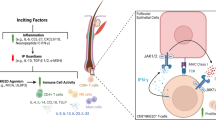Abstract
It has been suggested that immunological factors play a major role in the pathogenesis of hypertrophic scars. Characteristically there is an onset of typical clinical features and, after a variable period of activity, there is a phase of remission. The factors which produce this progressive change in the scars are not clear, and it is not known if their manipulation could provide a therapeutic progress. In order to further investigate the pathophysiology, morphological studies have been performed. In active hypertrophic scars lymphocytic infiltrates are abundant. Among them activated T-cells represent 70% of infiltrates while in normotrophic scar activated T-cells make up 30% of lymphocytes, suggesting a role of these cells in the mechanisms leading to scar hypertrophy. Upon activation, the lesional T-cells release several cytokines which may induce anomalous expression of activation markers (HLA-DR, ICAM-1, CD36, IL-2R) on keratinocytes and fibroblasts of hypertrophic tissue. A wide range of cytokines has been examined: among those analyzed the only one that changes in the remission phase is IFNγ. In fact, IFNγ is highly expressed in lymphocytes in active hypertrophic scars while it is less expressed in the remission phase and in control samples.
Similar content being viewed by others
References
Alessio M, Gruarin P, Castagnoli C, Trombotto C, Stella M (1996) Primary ex vivo culture of keratinocytes isolated from hypertrophic scars as means for antigenic characterization of CD36. Br J Dermatol (in press)
Bloch EF, Hall MG, Denson MJ, Slay-Solomon V (1984) General immune reactivity in keloid patients. Plast Reconstr Surg 73:448–452
Bos DJ, Kapsenberg ML (1993) The skin immune system; progress in cutaneous biology. Immunol Today 14:75–78
Castagnoli C, Stella M, Magliacani G, Teich-Alasia S, Richiardi P (1990) Anomalous expression of HLA class II molecules on keratinocytes and fibroblasts in hypertrophic scars concequent to thermal injury. Clin Exp Immunol 82:350–354
Castagnoli C, Stella M, Berhod C, Magliacani G, Momigliano Richiardi P (1993) TNF production in hypertrophic scarring. Cell Immunol 147:51–54
Castagnoli C, Stella M, Magliacani G, Ferrone S, Momigliano Richiardi P (1994) Similar ectopic expression of ICAM-1 and HLA Class II molecules in hypertrophic scars following thermal injury. Burns 20:430–433
Castagnoli C, Stella M, Magliacani G, Richiardi P (1995) The role of TNF alpha and beta cytokines in scar hypertrophy in burn patients: an immunohistochemical study. Ann Med Burns Club 8:23–27
Castagnoli C, Stella M, Menegatti E, Calcagni M, Magliacani G, Teich Alasia S, Alessio M (1995) CD36 expression in hypertrophic scars. Ann Med Burns Club 8:214–218
Castagnoli C, Trombotto C, Stella M, Calcagni M, Momigliano Richiardi P, Magliacani G (1995) Interferon gamma and Interferon gamma receptor in post-burn hypertrophic scars: it is a remission marker? Abstracts of VI Congress of European Burns Association
Cracco C, Stella M, Teich Alasia S, Filogamo G (1992) Comparative study of Langerhans cells in normal and pathological human scars II. Hypertrophic scar. Eur J Histochem 36:53
Cohen IK, McCoy T, Mohanakumar T, Diegelmann RF (1979) Immunoglobulin, complement and histocompatibility antigen studies in keloid patients. Plast Reconstr Surg 63:689
Griffiths CEM, Voorhees JJ, Nickoloff BJ (1989) Characterization of ICAM-1 and HLA-DR expression in normal and inflamed skin: modulation by recombinant gamma interferon and tumor necrosis factor. J Am Acad Dermatol 20:617–624
Janssen de Limpens AMP, Cormane RH (1982) Studies on the immunologic aspects of keloid and hypertrophic scars. Arch Dermatol Res 274:259–264
Kisher CW, Shetlar MR, Shetlar MR, Chvapil M (1983) Immunoglobulins in hypertrophic scars and keloids. Plast Reconstr Surg 71:821
Kovacs EJ (1991) Fibrogenic cytokines: the role of immune mediators in the development of scar tissue. Immunol Today 12:17–23
Kupper TS (1990) Immune processes in cutaneous tissues. Mechanisms and speculation. J Clin Invest 86:1783–1789
Linares HA (1996) From wound to scar. Burns 22:339–352
Lisby S, Ralfkiaer E, Hansen ER, Vejlsgaard GL (1990) Keratinocyte and epidermal leukocyte expression of CD36 (OKM5) in benign and malignant skin diseases. Acta Derm Venereol 70:18–22
Marks F, Furstenberger G (1993) Proliferative responses of the skin to external stimuli. Environ Health Perspect 101:95–102
Muir IFK (1990) On the nature of keloid and hypertrophic scars. Br J Plast Surg 43:61–69
Magliacani G, Stella M, Ferrero R, Merlino G, Arturi L, Calcagni M, Pezzuto C, Risso D, Bergamin F, Rivolin A, Castagnoli C (1994) Epidemiology of pathological scarring in burnt patients. Abstracts 9th Congress of the ISBI, p 473
Nickoloff BJ, Mitra RS, Green J, Zheng X-G, Shimizu Y, Thompson C, Turka LA (1993) Accessory cell function of keratinocytes for superantigens. J Immunol 150:2148–2159
Nickoloff BJ, Turka LA (1994) Immunological functions of non-professional antigen-presenting cells: new insights from studies of T cell interactions with keratinocytes. Immunol Today 15:464–469
Peackock EE jr, Madden JW, Trier WC (1970) Biological basis of treatment of keloid and hypertrophic scars. South Med J 63:755
Peruccio D, Castagnoli D, Stella M, D'Alfonso S, Momigliano Richiardi P, Magliacani G, Teich Alasia S (1994) Altered biosynthesis of TNF alpha is involved in post burn hypertrophic scars. Burns 20:118–121
Stella M, Castagnoli C, Magliacani G, Richiardi P (1989) Fisiopatologia della cicatrizzazione patologica (Revisione Bibliografica) Riv Ital Chir Plast 21:199–208
Stella M, Castagnoli C, D'Alfonso S, Menegatti E, Magliacani G, Richiardi P (1994) Cytokine expression in hypertrophic scarring. Abstract 9th Congress of the ISBI 168
Vejlsgaard GL, Ralfkiaer E, Avnstorp C, Czajkowski M, Marlin SD, Rothlein R (1989) Kinetics and characterization of ICAM-1 expression on keratinocytes in various inflammatory skin lesions and malignant cutaneous lymphomas. J Am Acad Dermatol 20:782–792
Viac J, Chardonnet Y (1990) Immunocompetent cells and epithelial cell modifications in molluscum contagiosum. J Cutan Pathol 17:202–205
Author information
Authors and Affiliations
Rights and permissions
About this article
Cite this article
Stella, M., Castagnoli, C., Trombotto, C. et al. Interrelationship between immunocompetent and structural cells in post-burn scars. Eur J Plast Surg 21, 8–13 (1998). https://doi.org/10.1007/BF01152416
Received:
Accepted:
Issue Date:
DOI: https://doi.org/10.1007/BF01152416




